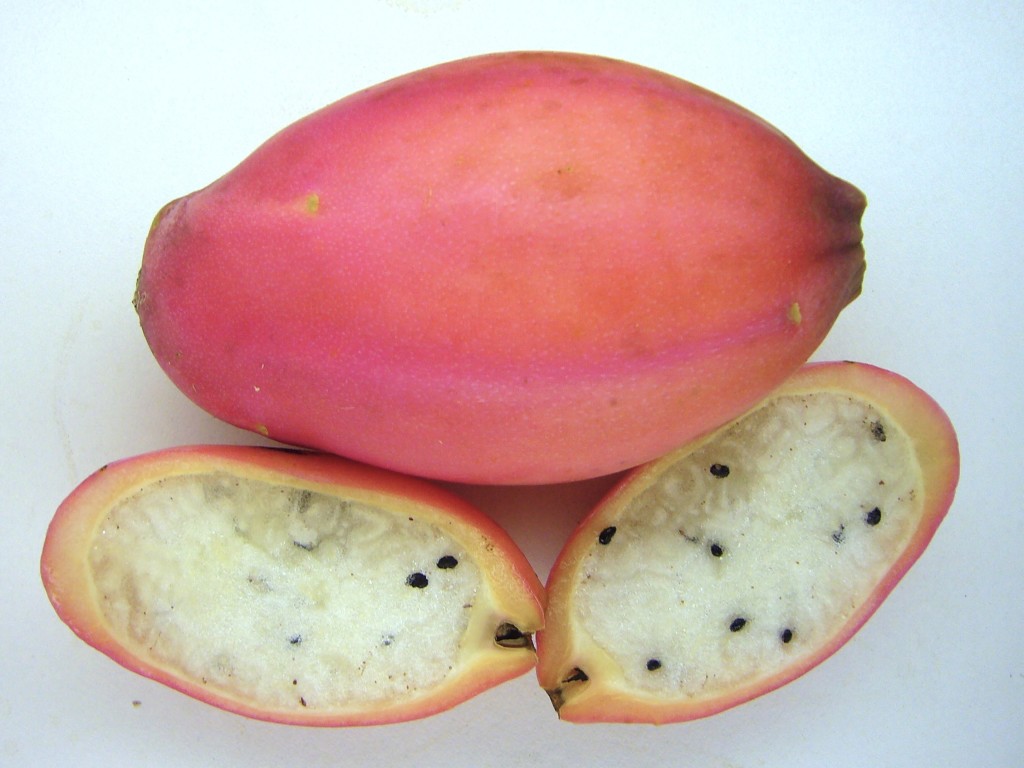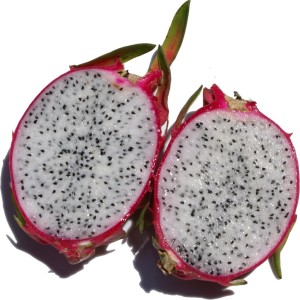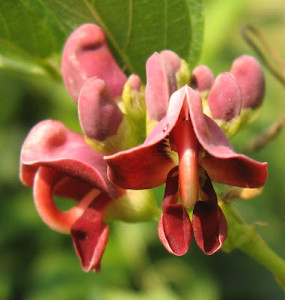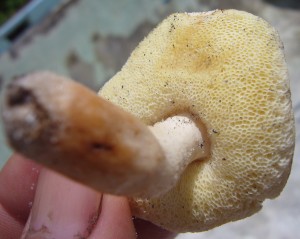Let’s get serious about Cereus. They all have edible fruit. I could stop the article right there but in many ways Cereus are like grapes: It’s fairly easy that you have one, but the exact species can be vexing. Seven spines in a cluster, nine spines, long, short, maybe even made-up non-existing species or some that exist only commercially. There’s quite a variety.
I collect the fruit from neighbors’ cultivated plantings to escaped ones in the “wild” around parks in south Florida (where they ere no doubt dumped as lawn refuse by some homeowner.) Huge cream-colored blossoms turn in to large red fruit, edible many ways. A favored method is to put the fruit in the frig. Chill it, cleave it, then eat the white pulp with a spoon. It is mildly sweet with the texture of over ripe watermelon. I this genus the black seeds are soft but in other cactuses they can be extremely tough and can damage teeth. Those seeds need to be roasted or ground raw into a buttery paste. A commercial version of this “tuna” is available in some markets called “Dragon Fruit.” The above tastes the same to me. And why pay for it when you can get it for free, and without pesticides and the like? To read more about the Cereus go here.
Blossoming now and making it easy to spot are Ground Nuts, or Apios americana. This is a vine found in wet spots nearly everywhere east of the Rockies. It has clusters of maroon per blossoms, which means “wings and keels.” The four petals of pea blossoms arrange themselves differently than most blossoms. Two flare out and two form together creating what looks like a boat’s keel and two wings. Grounds Nuts are a foraging staple and were also the second plant product exported from the new world to the old world. The first was Sassafras wood. While we find Ground Nuts in damp spots they will happily grow in a regular garden producing edible tubers for many years. More to the point, once you know what the underground tubers look like you can easily identify them anywhere you find them. To learn more about Ground Nuts go here.
This past week EatTheWeeds.com past a milestone of sorts. I answered my 5,000th question sent to the site. There were actually more questions submitted but some couldn’t be published and some shouldn’t be published. The site also received about 150 pieces of spam a day, most of it caught by a filter. Maintaing it and the Green Deane Forum is a full time job… and this weekly newsletter. While foraging seasons come and go on the GD forum we talk foraging all year. Join us. there should be a button to your upper right that will tell you more.
Foraging classes this week are far flung, John Chestnut Park near Tarpon Springs, and Lake Woodruff National Wildlife Refuge in Deland. Both classes will be held as enough have signed up for them. For more information click here.
A reminder the Florida Herbal Conference 2014 will be held in Deland again this coming February. Susan Weed will be the among featured speakers. And again this year there is an early bird special for those who sign up before Oct. 31 and use the code EATTHEWEEDS. For the third year in a row I will be leading weed walks at the herbal conference, a challenge in winter on dry ground. The walks are usually first thing in the morning when the air is cool and camp fires warm. Although it is the Florida Herbal Conference it draws teachers and students from all over North America. And as mentioned above you get a discount because you read this newsletter.
My mystery mushroom of late seem to be a Gyroporus. It’s a small genus with only 10 or so species worldwide and seven in the eastern US which should reduce one’s guesses. Color and staining reduced it to three possibilities. Lack of hair and scales reduced it to two. No chemical reaction eliminated one of those. Unfortunately my specimen isn’t true to form so I’m not sure of the identification though I have no choices left. Best guess, which means I don’t know and don’t eat it, is Gyroporus subalbellus. I don’t teach about mushrooms because I am not qualified to. They are difficult to identify but interesting none the less. I like studying mushrooms in the Boletus group because there are no deadly ones or ones that cause lasting damage. Some can make you really sick but unless your health is already compromised in some way they are not deadly.
_______________________________________
Even though my foraging videos are for free on the internet some foragers like to have their own copy. My nine DVDs have 15 videos each, from 01 to 135, and come in nine cases each with a picture of yours truly on it. In the process of moving the videos to DVS some of them were enhanced slightly from the version on the Internet. In a few months I hope to have volume 10 available as well. I print and compile the sets myself so if you have any issues I handle it personally. There are no middle men. To learn more about them or to order the DVS click here.









Dear Sir,
When visiting the deserts of Mexico in 1951, the prickly pears or tunas were plentiful. I soon learned that their miniscule spines (if handled carelessly) would work their way into ones skin and be painful and difficult to remove. The Mexicans taught me how to harvest them with a pen knife so as not to get stuck with them. They were juicy and delicious down there but the wild ones here in Florida are always rather bland. I wonder if cultivating and fertilizing a cactus plant would improve the quality of the Florida fruit? I think you should have warned people about the prickly spines.
Yours truly,
Rich Morales
I would think that the words “prickly pear” and “cactus” should be warning enough for most people 🙂
Our prickly pear cactus had fruit on it this year. So I made prickly pear lemonade. It was delicious!
We have a common one here in Finland called Boletaceae (Tatit) sporting the non-scales, and looks quite similar to yours. When you break it open, the inside edge of the break will turn blue for a few minutes.
I just discovered a whole cluster of Prickly Pears acroos the street from a beach in Ocean Springs Mississippi. they stretch over several lots and then a block away there are more. Many homes along with traditional landsacpe was destroyed in the storm. Neighbors tell me that before Hurricane Katrina, there were no prickly pears in the area. I have found many wild edibles and other species out of thier natural environment over the past few years. I did not come to the MS Gulf Coast from Florida until after Katriina so I can’t say what was here before, but I think that the violent storm has dislodged many species and carried them to different habitats.
I wonder if you have made similar discoveries after satorms in Florida.
I have tried many wild tunas, or prickly pears and never been hugely impressed. On the other hand, I have had some cultivated varieties that had delicious, subtle flavors. On a related note, I have also had good, and rather flat tasting cereus cactus fruit.
Tim
After going through this issue of Eattheweeds, especially on the cactus “Cereus “, I was encouraged to identify what I have in my garden : four cacti grown in pots for ornamental purpose. These , I have found to be : 1/ Opuntia littoralis var. vaseyi, 2/ Agave havardiana, 3/ Aloe barbadensis (Aloe vera) , and 4/Gymncalycium baldianum. I’m familiar enough with the fruit of the first as I’ve a taste of it several times when I was in Sana’a – Yemen. Interestingly , the last cactus ten days ago has shown a lovely scarlet – red single flower which unfortunately has closed by evening that same day and never opened again. Just yesterday, the same cactus was generous enough to give us another chance to make us enjoy the beauty of this fabulous rare flower – so fond of it that I ‘ve sent an image of it to my son – now far away from us – on the occasion of his birthday. This second flower which also closed by evening and forbade to open this day is now lying close to the first. Let’s hope for two fruits.
‘In the wild, Sudan, my home, is not known to be rich in cacti; but is very rich in succulents. Erkweet area in the Red Sea Hills is where to look for as a lot of Eurphorbias are indigenous.